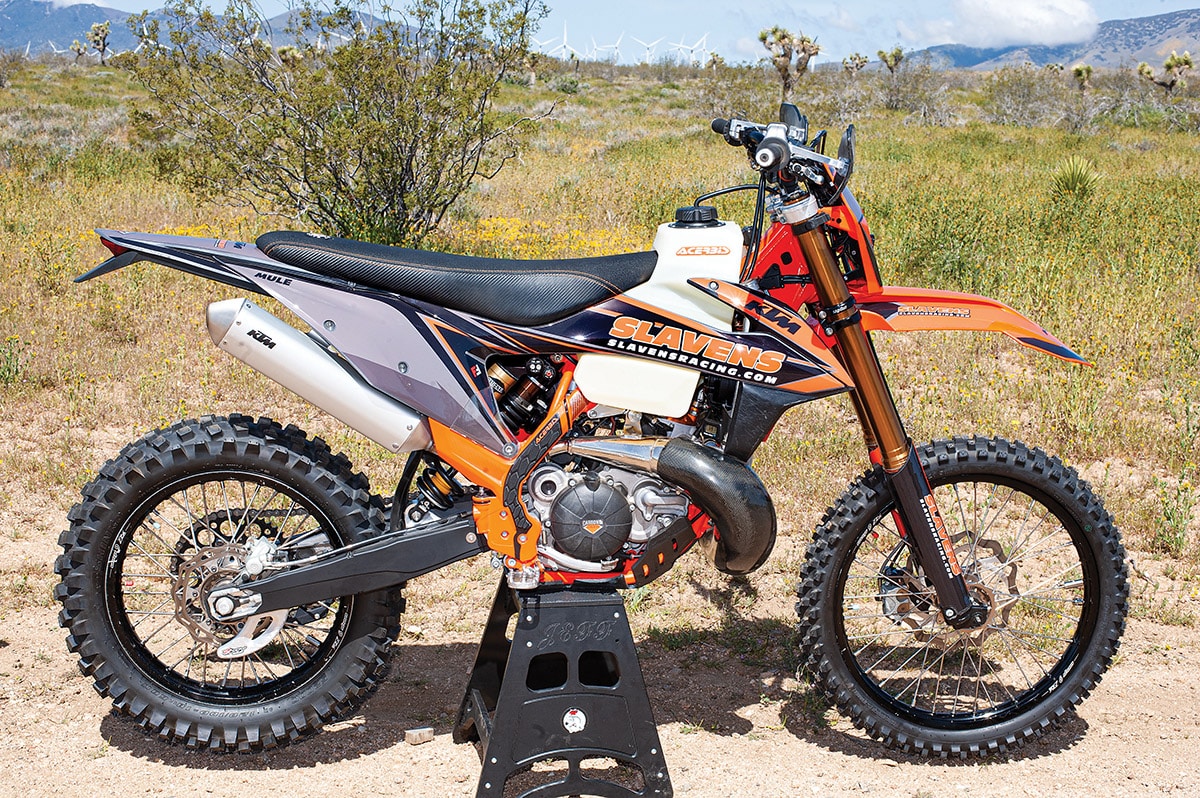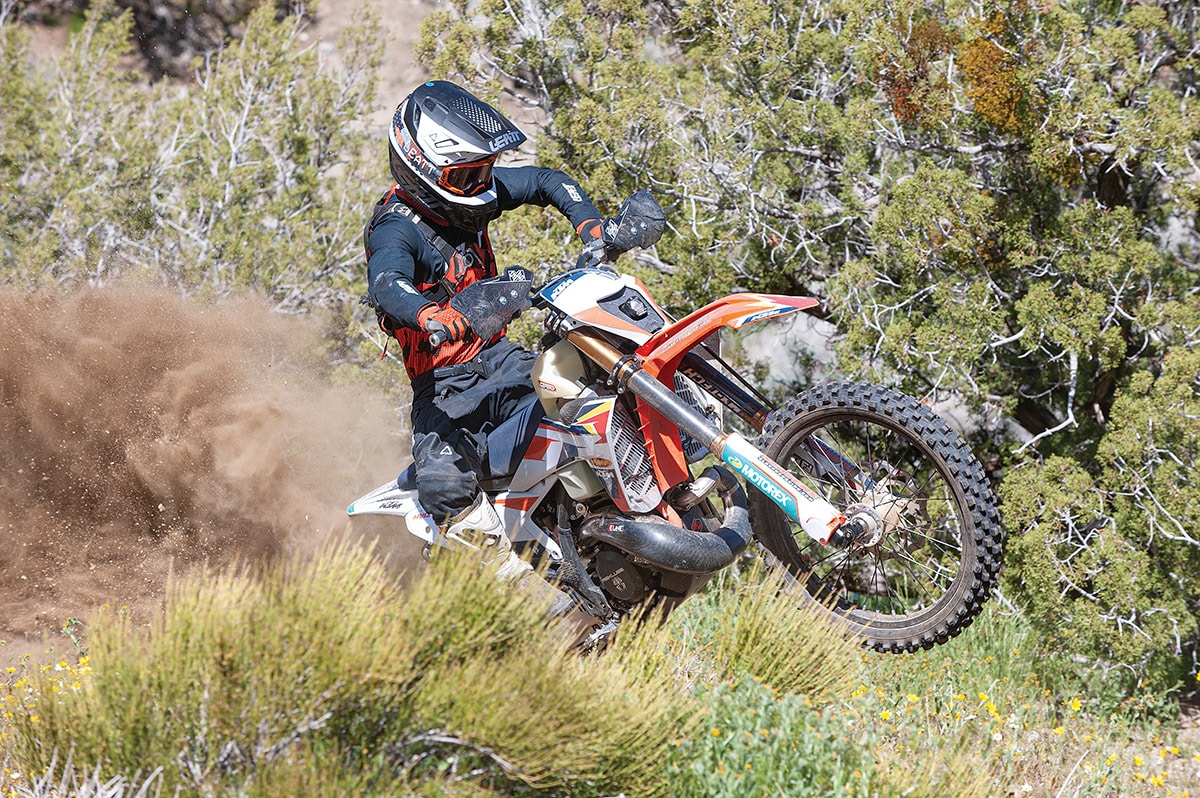Jeff Slavens has built his reputation on being tough, gruff and a man who doesn’t deal well with fluff. He’s an accomplished off-road pilot and is passionate about riding in his home state of Colorado. He’s also done quite well in the dirt bike world with Slavens Racing, his company that has offered a steady diet of parts, upgrades, video tutelage and product dissection that makes the off-road world a better place.
Jeff is also a full-blown 300 addict. This story is based on his two personal machines—a KTM 300XC-W TPI and the new 300XC TBI. He has lived with the machines in stock trim before throwing the weight of his company at them in an effort to mold them into the perfect storm. These are his sage remarks based on his experience and, importantly, painted into the off-road environment that he bleeds for—high elevations, technical and rocky!

FIRST IMPRESSION: KTM 300XC-W TPI
With all-new bikes, I ride them bone stock for a tank of gas. This allows me to establish a baseline of the engine and suspension performance, and to evaluate any changes and alleged improvements from the previous model year. The 2020 through 2023 300XC-W TPI models have the same frame, suspension and engine, but each model has received minor updates to the fueling and suspension settings. I also own a 2020 300XC-W TPI, so the 2023 was not a new experience.
The KTM 300XC-W is designed for trail riders, not racers; although, it can be—and is—used for both applications. Because of their intended use, the XC-W/EXC model’s suspension is somewhat compliant in the small trail trash, but lacks chassis stability and bottoming resistance when the trail opens up and the pace becomes faster.
I’ve owned several TPI models and knew what to expect from the engine. Although smooth and ridable, in stock form it lacks the bottom-end grunt and midrange pull that riders were accustomed to with the previous carbureted models. I’m a motor-head, and in short order, I knew the stock horsepower—or lack thereof—would not be enough for the steep, high-elevation riding that I do in my home state of Colorado.

FIRST IMPRESSION: KTM 300XC TBI
The 2023 300XC is a whole new animal, and it is a beast. It has a new chassis and swingarm that is much more rigid than previous XC models, and the new 300 TBI engine may be intimidating to riders less skilled than Graham Jarvis. It is a brute any way you measure it. The 300XC TBI has more torque and horsepower than any previous 300 model of any brand.
Although both bikes have a familiar KTM ergonomic feel, the similarities end when you head down the trail. The XC-W has a mellow and friendly power delivery, while the XC is very bold and barky. The XC-W chassis and suspension are relatively comfortable, while the XC is harsh and unfriendly in rocks and roots. The XC-W is a little wiggly and wobbly at higher speeds and in the whoops, whereas the XC is stable in whoops and higher-speed trail sections but at a cost of poor ride quality.
The XC is designed and intended to be used for racing; however, most of them never see a racecourse and are used as trail bikes. Therefore, the new stiffer chassis and swingarm, along with stiffer XC valving settings, are not well suited for most buyers.

MODS FOR THE 300XC-W
Engine/performance: I live at 6300 feet elevation and ride from 7000 to 12,000 feet elevations. At 6300 feet elevation, bikes have over 20 percent less compression compared to sea level, and as I ride up in elevation, the mountain air becomes thinner and that equals a further reduction of horsepower.
To counter the negative effects of elevation, two things need to be done: increase compression and correct fueling. To increase compression, I use our proprietary Slavens Mule S3 high-compression head with a Mountain insert. The increased compression gives a big boost to the low-end grunt and mid-range pull.
We have several options to correct the fueling for low- or high-elevation applications. The big daddy of them all is the Slavens Mule GET ECU. The Slavens Mule GET ECU comes loaded with two proprietary performance maps, which are tuned to match your stock or modified engine, exhaust, airbox mods, etc., and to match the elevation where you ride. We also offer the Coober ECU, which is a simple plug-and-ride option, and we offer a reflash service for your stock ECU. We do this in-house. It is a less expensive option that gives a big boost in horsepower and torque. A Slavens remapped ECU was used during the Dirt Bike magazine test.
Suspension mods: My old carcass has been through a lot of traumas over the years. Therefore, I am more than willing to throw the checkbook at great suspension that provides comfort, stability, and precise tracking and steering. Up front we fit a Slavens Mule MX-Tech Lucky fork cartridge in the MX-Tech compete fork, and out back I use the Slavens Mule MX-Tech National shock. I’ve been using this fork for months, and it has been upgraded to the Slavens Mule MX-Tech Raven fork, which was used on my XC! I have worked closely with Jeremy at MX-Tech for the last 30 years to develop off-road specs that are called the “Slavens Mule” settings. The fork and shock are very compliant in rocks and roots, stay up in the travel, are extremely stable at speed, and have bottoming resistance second to none. With the Huck Valve anti-bottoming system, there is never a metal-to-metal bottoming scenario.

MODS FOR THE 300XC TBI
Engine/performance mods: The new 300 TBI engine is a monster. It is the first 300 since 1990 when they came out that I have not modified it to increase torque and horsepower. My focus on the TBI engine is to make it more ridable. Currently, there are few parts and pieces on the market to work with, so I installed a Rekluse CX clutch and a slower-turning throttle cam. That combo made the power delivery more manageable. Steahly Off-Road flywheel weights just arrived and are available on slavensracing.com. That will be the next thing I add to mellow out the monster.
Suspension mods: The new stiffer XC chassis, stiffer swingarm and stiffer XC valving add up to a combination that is not user-friendly in rocks and roots. It’s harsh, lacks compliance and does not track well in those conditions. For blown-out, whooped-out and higher-speed trails it gets the job done, but for rocky and rooty Colorado trails the stock suspension setup is brutal and not confidence-inspiring.
I first re-valved the stock WP AER fork and WP Xact shock with specs given to me by Greg at Factory Suspension Works. Greg worked for many months developing settings with a Husqvarna FC250 that has the same chassis and came on the market in February 2022. His settings setup is a night-and-day improvement over stock, but I still wanted more.
Go big or go home, so I got out the check book. I installed a Slavens Mule MX-Tech National shock and Slavens Mule MX-Tech Raven complete fork. Working with Adam and Jeremy at MX-Tech, we developed our Mule spec valving for both the shock and fork. I believe that this combo is flat excellent via incredible compliance, stability, tracking and steering precision, which propel them a leap above re-valved OEM components. They eat rocky terrain and spit out smiles!

MUST-HAVE ITEMS (BOTH MACHINES)
I hate buying a nice lightweight bike and then turning it into a nice little porker. Every bolt-on item gets evaluated for its performance potential versus weight gain.
Guards, guards and more guards. These days there is a guard available for everything. I am somewhat of a minimalist when it comes to guards because they add weight. One of the first guards I install are the Bullet Proof Designs radiator guards. These offer great impact protection and flow air better than other guards on the market. I use SXS handguards because they do not trap my hands like full wrap-around guards, which can possibly cause wrist or hand fractures. Other guards are an AXP Extreme plastic skid plate on the XC-W, a Molecule unit on the XC, E Line carbon fiber pipe guards and fork guards are used on both, with plastic swingarm guards and a Zip-Ty rear disc guard (XC-W) and Bullet Proof on the XC.
Cooling fans are a must-have item when riding tight and technical trails. High-flow pump impellers and different coolants help reduce the engine temp a little, but a fan is required if you want to keep it cool. I also use a second digital temperature readout mounted on my XC Gear Mako 360 handlebar mount to keep a close eye on engine temps when testing ECU maps.
For traction control, I currently used a Bridgestone M59 at 12 psi up front and a Shinko 520DC at 5–6 psi rear combined with Tubliss on the XC-W. With the 300XC, I felt that the stock tires were good all-around meats, but I prefer a setup that is more focused on Colorado trail conditions. I switched to an 80/100-21 Bridgestone X31 up front and an IRC JX8 Gekkota Gummy rear tire. Both are matched up with Nuetech TUbliss inserts for light weight and so I can run air pressure compatible with the conditions.
If you want a happy butt, you must cough up some cash for a Seat Concepts Comfort seat. It’s absolutely the most comfortable saddle on the market and a huge improvement over the KTM board seat.
Fastway Evo 4 stainless steel footpegs mounted in the “low boy” position are my go-to peg. They put my tall carcass in a more comfortable and effective position. They also take abuse from rocks and roots. On the XC, I fit on the EXT pegs, which have an extension that protects against Achilles tendon damage.
If you enjoy riding long loops or multi-day point-to-point rides, an oversized fuel tank is a must. I prefer the Acerbis 3.1-gallon fuel tank on the XC-W, and the 3.2-gallon unit on the XC (the stock tank is only good for about 45 miles).

FINAL THOUGHTS
Dirt Bike: If you could only do one mod on the 300XC-W TPI machine, what would it be?
Jeff Slavens: Besides all the usual guards, I would focus on the fuelinjection mapping to correct the lean issues that can make for (at least in my mind) subpar performance.
DB: If you could only do one mod on the 300XC TBI machine, what would it be?
JS: Definitely the suspension. The engine rocks, but the suspension settings combined with the new stiffer chassis and swingarm make for an uncomfortable and confidence-damaging experience, at least here in my home state.
DB: If you could have only one of these, what’s your pick and why?
JS: The XC-W gets pulled out of the man cave more often than the XC because it is more forgiving and more comfortable. The XC-W power is more manageable, especially in the tight stuff, and the XC-W rolling chassis is more comfortable for longer loops. If I could only use one word to describe the XC, it would be “intense!” It is not a lazy man’s bike for casual rides. It begs you to twist the throttle hard and hold on tight. It’s a man’s machine morphed into a stellar Colorado off-roader by virtue of the Rekluse Core “auto” clutch and the suspension updates. They’re pricey but make me smile.





Comments are closed.